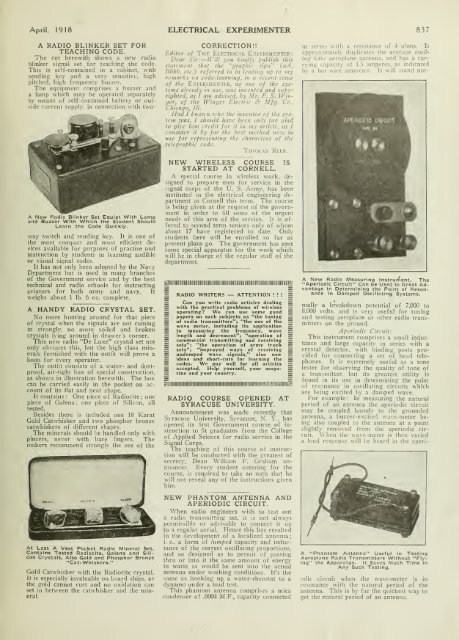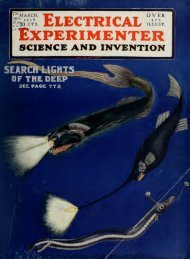The Electrical experimenter
The Electrical experimenter
The Electrical experimenter
Create successful ePaper yourself
Turn your PDF publications into a flip-book with our unique Google optimized e-Paper software.
April, 1918 ELECTRICAL EXPERIMENTER 837<br />
A RADIO BLINKER SET FOR<br />
TEACHING CODE.<br />
<strong>The</strong> cut herewith shows a new radio<br />
blinker signal set for teaching the code.<br />
This is self-contained in a cabinet, with<br />
sending key and a very sensitive, high<br />
pitched, high frequency buzzer.<br />
<strong>The</strong> equipment comprises a buzzer and<br />
a lamp which may be operated separately<br />
by means of self-contained battery or outside<br />
current supply, in connection with two-<br />
A New Radio Blinker Set Equipt With Lamp<br />
and Buzzer With Which the Student Should<br />
Learn the Code Quickly.<br />
way switch and sending key. It is one of<br />
the most compact and most efficient devices<br />
available for purposes of practise and<br />
instruction by students in learning audible<br />
or visual signal codes.<br />
It has not only been adopted by the Navy<br />
Department but is used in many branches<br />
of the Government service and by the best<br />
technical and radio schools for instructing<br />
aviators for both army and navy. It<br />
weighs about 1 lb. 6 oz. complete.<br />
A HANDY RADIO CRYSTAL SET.<br />
No more hunting around for that piece<br />
of crystal when the signals are not coming<br />
in strongly, no more soiled and broken<br />
crystals lying around in drawer's corner.<br />
This new radio "De Luxe" crystal set not<br />
only obviates this, but the high class minerals<br />
furnished with the outfit will prove a<br />
boon for every operator.<br />
<strong>The</strong> outfit consists of a water- and dustproof,<br />
air-tight box of special construction,<br />
as shown in illustration herewith. <strong>The</strong> box<br />
can be carried easily in the pocket on account<br />
of its flat and neat shape.<br />
It contains: One piece of Radiocite; one<br />
piece of Galena: one piece of Silicon, all<br />
tested.<br />
Besides there is included one 18 Karat<br />
Gold Catwhisker and two phosphor bronze<br />
catwhiskers of different shapes.<br />
<strong>The</strong> minerals should lie handled only with<br />
pincers, never with bare fingers. <strong>The</strong><br />
makers recommend strongly the use of the<br />
At Last A Vest Pocket Radio Mineral Set.<br />
Contains Tested Rediocite, Galena and Silicon<br />
Crystals, Also Gold and Phosphor Bronze<br />
"Cat-Whiskers."<br />
Gold Catwhisker with the Radiocite crystal.<br />
It is especially invaluable on board ships, as<br />
the gold cannot rust and no oxidation can<br />
set in between the catwhisker and the mineral.<br />
CORRECTION!!<br />
Editor of <strong>The</strong> Elf.ctrical ExpERIM ENTER<br />
Dear Sir:— Will you kindly publish this<br />
statement that the "graphic sign" (aA,<br />
Bbbb, etc.) referred to in leading up to my<br />
remarks on code-learning, in a recent issue<br />
of the Experimenter, as one of the systems<br />
already in use, was invented and copyrighted,<br />
as I am advised, by Mr. F. S. Winger,<br />
of the Winger Electric & Mfg. Co.,<br />
Chicago, III.<br />
Had I known who the inventor of the system<br />
was, I should have been only too glad<br />
to give him credit for it in my article, as I<br />
consider it by far the hest method noiv in<br />
use for representing the characters of the<br />
telegraphic code.<br />
Thomas Reed.<br />
NEW WIRELESS COURSE IS<br />
STARTED AT CORNELL.<br />
A special course in wireless work, designed<br />
to prepare men for service in the<br />
signal corps of the U. S. Army, has been<br />
instituted in the electrical engineering department<br />
at Cornell this term. <strong>The</strong> course<br />
is being given at the request of the government<br />
in order to fill some of the urgent<br />
needs of this arm of the service. It is offered<br />
to second term seniors only of whom<br />
about 17 have registered to date. Only<br />
students here will be enrolled so far as<br />
present plans go. <strong>The</strong> government has sent<br />
some special apparatus for the work which<br />
will be in charge of the regular staff of the<br />
department.<br />
= RADIO WRITERS ATTENTION ! ! ! =<br />
Can you write radio articles dealing<br />
= with the practical problems of wireless<br />
= operating? We can use some good<br />
= papers on such subjects as "the tuning<br />
= of radio transmitters"; "the use of the<br />
== wave meter, including its application<br />
= to measuring the frequency, wave<br />
^ length and decrement"; "operation of<br />
EE commercial transmitting and receiving<br />
=B sets"; "the operation of army truck<br />
== sets"; "improyed ways of receiving<br />
= undamped wave signals," also new<br />
= ideas and short-cuts for learning the<br />
= codes. We pay well for all articles<br />
accepted. Help yourself, your maga-<br />
== zine and your country.<br />
illllllllllllllllllllllllllllllllllllllll!lllllllllllllllllllll!ll!!lllllll!lllll!l!ll!ll!lil!lllllllllliy<br />
RADIO COURSE OPENED AT<br />
SYRACUSE UNIVERSITY.<br />
Announcement was made recently that<br />
Syracuse University, Syracuse, N. Y., has<br />
opened its first Government course of instruction<br />
to fit graduates from the College<br />
of Applied Science for radio service in the<br />
Signal Corps.<br />
<strong>The</strong> teaching of this course of instruction<br />
will be conducted with the greatest of<br />
secrecy. Dean William P. Graham announces.<br />
Every student entering for the<br />
course, is required to take an oath that he<br />
will not reveal any of the instructions given<br />
him.<br />
NEW PHANTOM ANTENNA AND<br />
APERIODIC CIRCUIT.<br />
When radio engineers wish to test out<br />
a radio transmitting set, it is not always<br />
permissible or advisable to connect it up<br />
to a regular aerial. Hence this has resulted<br />
in the development of a localized antenna;<br />
i. e., a form of lumped capacity and inductance<br />
of the correct oscillating proportions,<br />
and so designed as to permit of passing<br />
thru or into it the same amount of energy<br />
in watts as would be sent into the actual<br />
antenna under working conditions. It's the<br />
same as hooking up a water-rheostat to a<br />
dynamo under a load test.<br />
This phantom antenna comprises a mica<br />
condenser of .0004 M.F., capacity connected<br />
:<br />
in series with a resistance of 4 ohms. It<br />
approximately duplicates the average trailing<br />
1^H<br />
wire aeroplane antenna, and has a carrying<br />
capacity of 1.5 amperes, as indicated<br />
by a hot-wire ammeter. It will stand nor-<br />
APERIODIC CIRCUIT 1<br />
type m<br />
.. 1<br />
A New Radio Measuring Instrument. <strong>The</strong><br />
"Aperiodic Circuit" Can be Used to Great Advantage<br />
in Determining the Point of Resonance<br />
in Damped Oscillating Systems.<br />
mally a breakdown potential of 7,000 to<br />
8,000 volts, and is very useful for tuning<br />
and testing aeroplane or other radio transmitters<br />
on the ground.<br />
Aperiodic Circuit:<br />
This instrument comprises a small inductance<br />
and large capacity in series with a<br />
crystal detector, with binding posts provided<br />
for connecting a set of head telephones.<br />
It is extremely useful as a tone<br />
tester for observing the quality of tone of<br />
a transmitter, but its greatest utility is<br />
found in its use in determining the point<br />
of resonance in oscillating circuits which<br />
are being excited by a damped wave.<br />
For example : In measuring the natural<br />
period of an antenna the aperiodic circuit<br />
may be coupled loosely to the grounded<br />
antenna, a buzzer-excited wave-meter being<br />
also coupled to the antenna at a point<br />
slightly removed from the aperiodic circuit.<br />
When t he wave-meter is then varied<br />
a loud response will be heard in the aperi-<br />
A "Phantom Antenna" Useful in Testing<br />
Aeroplane Radio Transmitters Without "Flying"<br />
the Apparatus. It Saves Much Time in<br />
Any Such Testing.<br />
odic circuit when the wave-meter is in<br />
resonance with the natural period of the<br />
antenna. This is by far the quickest way to<br />
get the natural period of an antenna.




